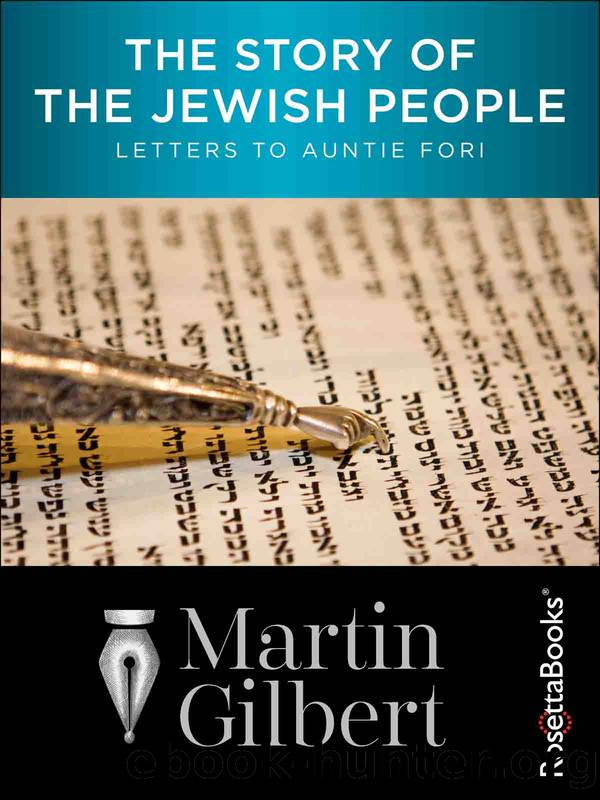The Story of the Jewish People by Martin Gilbert

Author:Martin Gilbert [Gilbert, Martin]
Language: eng
Format: epub
ISBN: 978-0-7953-3735-2
Publisher: RosettaBooks
Published: 2014-01-15T00:00:00+00:00
No. 87
Dearest Auntie Fori,
Outside the war zones Jews also made their contribution to the Allied war effort. Twelve military ambulances were presented to the South African army by Jewish refugees from Germany who had found shelter in South Africa during the war. A similar number of ambulances were presented to the British Army by the Jews of Palestine, who had raised the money for them.
Among the contributions made by individual Jews was that of J. Robert Oppenheimer, who led the atom bomb construction team at Los Alamos. Also working at Los Alamos were Richard Feynman, a future Nobel Prize winner, and James Franck, who opposed dropping the atom bomb on Japan. Theodore von Karmanâwhom I have already mentioned in an earlier letterâa Jew born in Budapest, co-ordinated American wartime jet propulsion research.
The ability of individual Jews to fight was matched by the ability of other Jews to narrateâto set down graphic accounts of the fighting around them. Among the war correspondents in the Allied armies during the Second World War were many Jews, for whom journalism had always been a popular profession. One of the first journalists on the American soldiersâ newspaper The Stars and Stripes was Ralph G. Martin, a graduate from the Missouri School of Journalism. At the age of twenty-two he was sent to North Africa as a combat reporter.
In the Soviet Union, the filmmaker Sergei Eisenstein, whose father was Jewish, joined with a number of leading Jewish intellectuals in the Soviet Unionâamong them the brilliant actor-manager Solomon Mikhoels, who had once played a masterly King Lear in Yiddishâto proclaim their pride in being Jews, and to raise international awareness of the mass murder of the Jews on Soviet soil.
Ilya Ehrenburg, a Soviet Jewish writer and novelist who had been a Russian war correspondent on the Eastern Front in the First World Warâand whom Uncle Bijju met, I believe, in the 1960sâwas in Paris at the time of the German invasion of France in 1940. His war reporting and subsequent book The Fall of Paris won him the Stalin Prize. Among the Jewish journalists from the West was Alexander Werth, Sunday Times correspondent in Moscow. His account of the liberation of Majdanek concentration camp in the summer of 1944 gave the world its first eyewitness account of the horrors of the Nazi death camps.
In the Americas, South Africa and Australia, far from the European war, Jewish life went on, in thousands of synagogues and millions of homes. Jewish schools taught and celebrated the traditional festivals and the Biblical story. Jewish creativity was not dimmed. Sometimes it focused on the war. Lillian Hellmanâs play Watch on the Rhine, first performed in New York in 1941, told the story of a German who risked his life to oppose the Nazi regime. Sometimes it was far removed from grim reality. Also in 1941, the American comedian Danny Kaye (born David Daniel Kaminsky, to Russian immigrant parents) came to prominence in the film Lady in the Dark, displaying a formidable talent
Download
This site does not store any files on its server. We only index and link to content provided by other sites. Please contact the content providers to delete copyright contents if any and email us, we'll remove relevant links or contents immediately.
| Haggadah | Hasidism |
| History | Holidays |
| Jewish Life | Kabbalah & Mysticism |
| Law | Movements |
| Prayerbooks | Sacred Writings |
| Sermons | Theology |
| Women & Judaism |
The Secret Power of Speaking God's Word by Joyce Meyer(2869)
Man's Search for Meaning by Viktor E. Frankl(2576)
Mckeown, Greg - Essentialism: The Disciplined Pursuit of Less by Mckeown Greg(2358)
MOSES THE EGYPTIAN by Jan Assmann(2347)
Devil, The by Almond Philip C(2245)
Unbound by Arlene Stein(2205)
The Complete Dead Sea Scrolls in English (7th Edition) (Penguin Classics) by Geza Vermes(2204)
I Capture the Castle by Dodie Smith(1938)
Schindler's Ark by Thomas Keneally(1779)
The Invisible Wall by Harry Bernstein(1727)
The Gnostic Gospel of St. Thomas by Tau Malachi(1712)
The Bible Doesn't Say That by Dr. Joel M. Hoffman(1621)
The Secret Doctrine of the Kabbalah by Leonora Leet(1553)
Political Theology by Carl Schmitt(1517)
The Jewish State by Theodor Herzl(1484)
A History of the Jews by Max I. Dimont(1466)
The Dead Sea Scrolls Bible by Martin G. Abegg(1442)
The Book of Separation by Tova Mirvis(1439)
Oy!: The Ultimate Book of Jewish Jokes by David Minkoff(1311)
